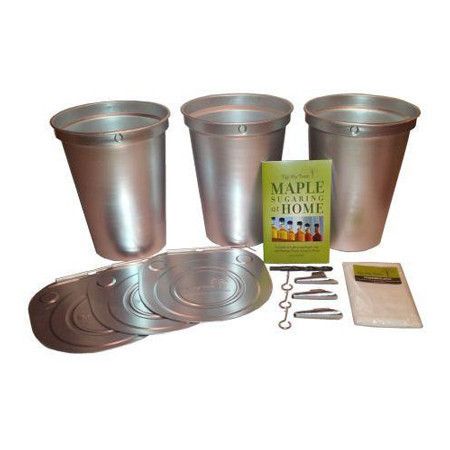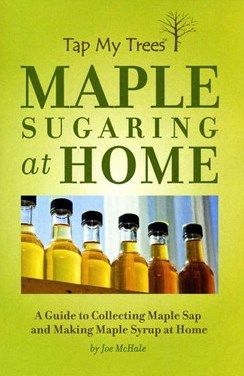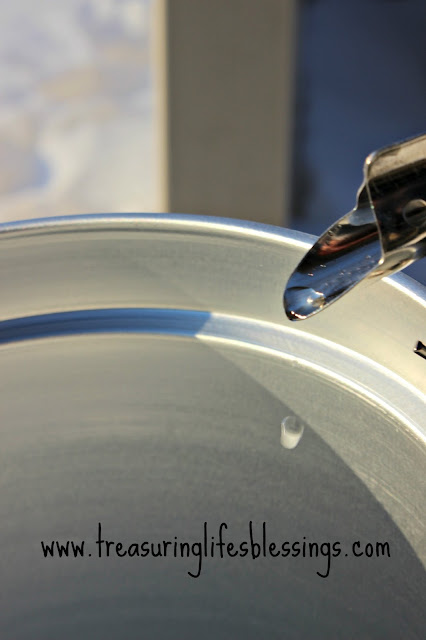We have only ever had maple syrup once in our house and that is because it was a gift to us from our neighbor. But NOW I can say we are going to have it again because we are making it ourselves this year!! That's right, Tap My Trees sent our family a Starter Kit with Aluminum Buckets to review. It came with everything we need to do the whole maple sugaring process from start to finish!
What is Tap My Trees?
Tap My Trees was born when Joe McHale wanted to teach his children about the origin of food. He wanted to give other families the equipment and information so they could experience the enjoyment of making their own maple syrup. He wrote an extensive guide to walk anyone through the simple process of maple sugaring.
What's included?
The kit contains:
-3 Aluminum buckets
-3 lids (that attach with a metal wire)
-3 spiles (the spigots that the sap drains into the bucket)
-3 hooks (to hang the buckets off the spiles)
-drill bit (7/16 with a 3/8 shank to insert the spiles)
-cheesecloth (for straining the sap)
-Maple Sugaring at home booklet
Upon opening our kit, I was pleasantly surprised to see what all was included. Everything was well packaged, to protect against scratches and padded well. The buckets & lids are a thick aluminum and not flimsy. The spiles are also made very durable and easily able to withstand the taps of a hammer to place them.
How to use it
The first place to start is with the 44 page booklet that came with the kit. It starts out explaining what each piece of equipment is and the role it plays in the maple sugaring process. Once you've become familiar with what all is included in your kit, it's time to move on to the next section of the booklet and learn to identify your maple trees.
This part of the process can be really educational as you learn how to identify your trees. There are 4 types of maple trees you can tap:
-Sugar Maple
-Black Maple
-Red Maple
-Silver Maple
He shares further in depth with information about each specific tree and it's characteristics. He also shared that you can tap Birch and Walnut trees (though their sap isn't quite as sweet as maple trees).
After you've identified your trees, he goes on to explain in the booklet step by step just how to tap your tree using each part of the kit. The section was very easy to understand. He explained each step in detail along with photos (black & white photos are all throughout this booklet). I have never done this process before nor have I ever witnessed how it was done and I found it easy to follow his instructions.
The rest of the booklet goes on to explain how to collect and store the sap then shares the process of how to turn the sap into maple syrup.
Generally speaking the time to collect sap is between early February through March. You want night time temps below freezing and day time temps above freezing. We were told we probably wouldn't be able to tap our trees in time to share our review. But just today as I reviewed what our weather has been and what it's going to be, I decided to go ahead and tap our red maple tree!
This is our red maple tree we used to tap.
Measuring the diameter of our tree to determine that we could put 2 taps in it.
Me drilling the hole at an angle. I had tape marked on the bit at 2 1/4" so I knew when to stop drilling.
Since our tree is larger, we were able to place 2 taps (he explains this in the booklet). We found following the step by step procedure extremely easy to follow and in a matter of minutes, we had 2 taps in, the buckets hung and sap flowing!
The sap is flowing!
What the whole set up looks like on the tree.
We can't wait to collect our sap to turn it into delicious maple syrup! This is definitely something we plan to continue to do as a family each year as I have no doubt this kit will hold up well.
Connect with Tap My Trees:
YouTube





















Oh, wow! I never knew a kit existed that makes tapping trees so easy. Our house is surrounded by what was once a famer's field, so we don't have any mature trees to tap, but perhaps my children's grandparents have some trees they would let us tap! And, I didn't realize that all those varieties produce sap. Will you leave the taps and buckets attached until the buckets are full, the sap quits flowing, or until the end of March?
ReplyDeleteThis sounds so cool!
ReplyDelete